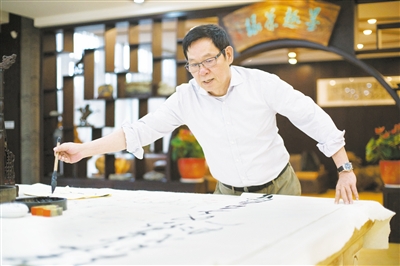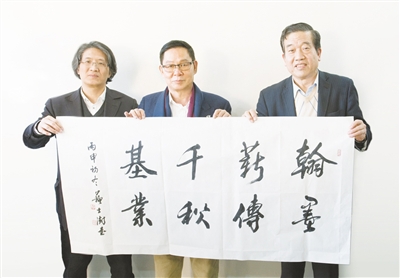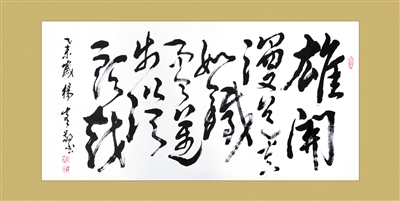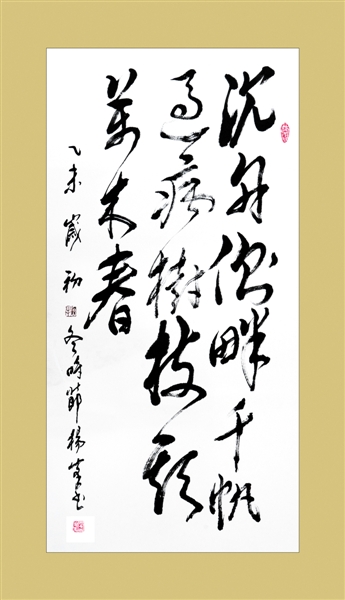【Profile】
Great Aim Group was founded by Yang Feng in 1994. After developing for 23 years, it has grown into a modernized, diversified and internationalized corporate group. Its scope of business covers the US, Beijing, Hong Kong, Macau, Shenzhen, Huizhou, Shanxi, Zhuhai and Hengqing New District of Zhuhai, etc., involving industries such as real estate which is widely known, financial sector, optical communication technology, intellectual property rights operation. As a council member of the State Intellectual Property Office, it has independently developed U-beacon system which has filled an international gap and won 32 patents for its independently developed technologies.

As the leader of Great Aim Group, Yang Feng appears a bit "derelict in duty": He loves photography. For seven years in a row, he has flied to the West of the US in different seasons to frame the marvelous spectacles in his mind. Finally, with his album of photos Pursuing Dream in the Wilderness, he won "Best of All Gold Award" and "Best Exhibit Award" in the 66th ceremony of Benny Award which is honored as "Oscar of Printing Industry" in the US and became the first Chinese to win this honor.
Influenced by the elderly, Yang was obsessed with calligraphy since his childhood. When he was small, he practiced it with water on bricks. He was told by the elderly that he should make the bricks wet through with water in each practice. Today he has collected thousands of calligraphy copybooks of famous calligraphers and has become a member of Chinese Calligraphers Association. He calligraphy works has ever been used by China Post as first-day cover of postage stamp for the Celebration of 65th Anniversary of the PRC and created a record of 130,000 Yuan in autumn auction of single character. However, he insisted on practicing calligraphy every day for decades.
Such a seed of Chinese culture and art in his bone has sprouted everywhere in the group and its subsidiaries. Lanbowan School of Zhongshan Experimental Primary School under the group has opened a special class of calligraphy, invited famous calligraphy teachers to give lessons. The calligraphy works of its students have won numerous prizes. "Influence by close association". The enthusiasm of Boss Yang in calligraphy art has infected all employees of the group and its subsidiaries. From high level to grass root, all people have displayed a strong atmosphere in the learning of traditional culture. Excellent traditional culture has become an important component of its corporate culture.
On December 8, 2016, Yang donated 25 million Yuan to China Literary and Art Foundation at the office building of Beijing Federation of Literary and Art Circles in the name of the group, which would be used for the calligraphy teachers training program for primary and middle schools across the nation undertaken by Chinese Calligraphers Association.
To many media people, few entrepreneurs will spend more time on their interest than their career; and fewer entrepreneurs are as professional in their interest as their career and can even rank top in related field at home and abroad; not to say real estate entrepreneurs will lift their interest to the height of social responsibility of the enterprise and put it into action and make it a big event influencing the inheritance of traditional Chinese culture.
Yang is such an "exception" in the eyes of common people.

A donation of 25 million Yuan originates from inheritance of the original intention from the elderly
Reporter: On December 8, 2016, Great Aim Group donated 25 million Yuan to China Literary and Art Foundation for a calligraphy teachers training program. As a private entrepreneur, why do you take such an action suddenly?
Yang: It is not sudden in fact. As a member of Chinese Calligraphers Association, I have an unusual enthusiasm in calligraphy. Today it is difficult for calligraphy class to be introduced into primary and middle schools. Due to the shortage of calligraphy teachers, calligraphy teaching cannot be organized normally in many schools. Facing this reality, we feel very upset and worried. Many people want to do something for the inheritance of calligraphy, but find it helpless. As an entrepreneur, it's lucky that I have the strength to make some contribution to the inheritance of calligraphy, for which I feel very proud.
Reporter: 25 million Yuan is a big sum. Why don't you directly aid a calligrapher with potential, but choose to fund the calligrapher teacher training for primary and middle schools?
Yang: From six years old I was asked by my grandpa to learn calligraphy. Later, after I went to school, I was always criticized by my teacher when I held a pencil in the same way as I held a writing brush. However, after I went home from school, I was praised by my grandpa, who said that I had laid a solid foundation in the practice of calligraphy. I have been enthusiastic about calligraphy for decades, perhaps because the example and verbal instruction from the elderly had buried a seed of enthusiasm in calligraphy in my childhood. Perhaps I choose to fund the inheritance of Chinese calligraphy just to carry forward the original intention of my grandpa.
Decades have elapsed in a blink. Now I have become the founder and leader of an enterprise. With the growth and development of the enterprise, generation after generation of new employee enter the enterprise. I find that there are few calligraphy lovers among the generations born in the 1980s, 1990s and fewer in the 2000s. Without the keyboard, none of them can write neatly. In the face of shortage of inheritors of calligraphy art, as a calligrapher lover and a member of Chinese Calligraphers Association, I am anxious about the current status and worried about the inheritance of Chinese calligraphy.
Reporter: So you choose to start from the source of education?
Yang: Yes, I wish to set an example by donating 25 million Yuan to the calligraphy teachers training program for primary and middle schools nationwide, do well in the fixed-point training of "calligraphy inheritance", and drive more entrepreneurs to support the inheritance of Chinese calligraphy with actual actions, thereby promoting the calligraphy teachers training for primary and middle schools. After teachers are trained and cultivated, we can then teach more students to practice calligraphy. I believe, the inheritance of our calligraphy by the youth must start from the cultivation of faculty.

Reporter: Just now you mentioned that a lot of youngsters know nothing about calligraphy, and can't write characters well. Indeed, as far as I am concerned, now many youngsters do not learn calligraphy. On one hand they are too busy with their work, on the other hand, they think that calligraphy is useless to their work. How do you think of such a notion?
Yang: In Dong Yu Biography of Confucianists of Brief History of Wei, Dong Yu said about reading, "Winter, the surplus of a year; night, the surplus of a day; cloudy and rainy weather, the surplus of time". So is the practice of calligraphy, which can be practiced at any spare time.
I don't agree with the notion that calligraphy is useless to work. I believe that "Conduct should go before doing things, and integrity is the precondition to success". In fact calligraphy and conduct have similarity. Calligraphy is the treasure of traditional Chinese culture, a national essence, which has abstracted the law of movement of the universe and blended the theories of sages in both ancient and present time. As a saying goes, "The character for man consists of one stroke to the left and another to the right; we learn to behave ourselves with our whole life", which is about the relationship between calligraphy and conduct. Su Shi, a great poet in the Song Dynasty of China, also said, "Calligraphy is a window to the personality of a man". From calligraphy we can see the character and behave of a man. Through the constraint of calligraphy rules, it will become our habit and is meaningful to regulate our behaviors.
Reporter: Great Aim Group has also built a school. Is calligraphy education offered in the group's school? How effective is it?
Yang: Lanbowan School under the group has opened various interest oriented classes, including calligraphy. The calligraphy works of many students have won various prizes. In the following, we will continue to strengthen the aspect, especially cultivate more professional calligraphy teachers.

Reporter: In 2015, your album of photos Pursuing Dream in Wilderness won two awards in the 66th ceremony of Benny Award for the printing industry of the US. Now you donated a big sum to fund the "Inheritance of Calligraphy" program. Photography and calligraphy are your interest, but few entrepreneurs can do so well in their interest and even combine their interest with social welfare and charity as you do. How do you think of the relationship between interest and career?
Yang: Many people believe that interest and money are closely tied and many integrate the two as a whole. They cultivate interest for earning money. Take photography as an example, in the circle of photography, there are many "masters", but few of them can earn money with the interest. One photo of the late Ansel Adams can be auctioned at a price of 800,000 US dollars, which is the only case. Today there is another example, who is my good friend Wang Jianjun. As a photographer of Western scenery, he is a practitioner that has achieved a perfect integration of interest and career. His benefit from his interest can satisfy his living needs. For the pursuit of my interest, I cannot earn money with my interest. Without money, I cannot satisfy my own interest. Therefore, I started up business first before satisfying my own interest. The album of photos taken in the west of the US is perhaps a fruit of practice in which I started up business to satisfy my own interest.
After my donation to Beijing Federation of Literary and Art Articles on December 8, 2016 was reported by news media, since I was a key member of the "Inheritance of Calligraphy Academic Guide Team of Chinese Calligraphers Association", recently leaders of some cities and education departments in the South China region have contacted me via China Federation of Literary and Art Circles and Chinese Calligraphers Association. They invited me to open fixed-point training base of calligraphy teachers for primary and middle schools in their regions. This is a great harvest and encouragement to me, for my original intention has been recognized by the society. I see that my donation can set an example for the society and it can be soon expected that a batch of calligraphy seeds can be cultivated.
Interpreted from the angle of career, my interest in calligraphy and photography has created my today and also is the dynamic force to drive me on in my career.
Reporter: As an entrepreneur mainly engaged in real estate, calligraphy and architecture seem unrelated to each other. In your opinion, is there any necessary connection between the two?
Yang: The calligraphy and architecture planning can be understood as "different in approach but equally satisfactory in result". Calligraphy emphasizes the balance of sparseness and denseness, which can be "so dense that no needle can be inserted" or "so sparse that even a boat can flow". Architecture planning also cannot do without a balance of sparseness and denseness. For example, the bricks of ancient architectures such as the Forbidden City follow a funny pattern of arrangement. They are not arranged in the same position, but a brick is placed on two bricks. Arranged like this, the whole appears stable and coordinated. The same requirement applies to the rule of calligraphy, which strives to achieve steadiness and orderliness.

Reporter: On the donation ceremony held by China Federation of Literary and Art Circles, I heard a key word about the purpose of donation. All leaders at the site have mentioned "cultivating 7,000 seeds of calligraphy". Can you talk about the actual significance of the key word?
Yang: The "Seeds of Calligraphy" we have mentioned in fact is "the aim of the project". Like the meaning of seed in biology, the "seed of calligraphy" also has a life. A seed buried in the earth can sprout, blossom and bear fruits, so can our "seeds of calligraphy". Through the project of "Inheritance of Calligraphy", we will select calligraphy lovers from the faculty of primary and middle schools nationwide. After a systematic and strict training, as seeds, they will be sown in the primary and middle schools and will also sprout, blossom and bear fruits.
Reporter: What requirements do you suggest for the regulation of "seeds"?
Yang: The coverage range of the term "regulation" is too wide. Here I simply talk about its general meaning. Chinese calligraphy is an art with Chinese characters as the written object. Chinese character integrates image, sound and meaning into one and is created following six principles (namely, pictograph, self-explanatory, associative, phonogram, mutually explanatory, loan), and forms man's unified understanding of natural phenomena and happenings. Since the ancient time, calligraphy has followed the same vein by worshiping image, rhyme, method, meaning, shape and quality, which can be called "Way of Calligraphy". Now that there is a way, there should be rules, just like "traffic rules" for drivers: Stop when the red light is on, go when the light turns green. According to the traffic rules of the UK, we must go on the left side of the road, while in China we go on the right side. Hong Kong's traffic rules have been introduced from the UK, so nowadays people still go on the left side. Therefore, the "Way of Calligraphy" is also under similar regulation as traffic rules. However, who will set these rules? In fact no one is qualified to set them. The rules can only be "inherited", which are the classical copybooks that have been passed down for thousands of years. Without these classical copybooks, calligraphy will be like a tree without roots and a river without source. And inheritance will be out of question. Like Hong Kong has learned the traffic rules from the UK, it is also inheritance. The life of calligraphy seed is also from inheritance. Calligraphy also involves natural beauty, which is an ultimate goal pursued by calligraphers.
Reporter: Does natural beauty mean creative existence?
Yang: Now that natural beauty is pursued, some people deny the existence of regulation. In fact, I think that natural beauty and regulation can co-exist in a certain space. I remember that an ancient calligrapher Cai Yong mentioned in Jiu-Shi that "Calligraphy originates from the nature, where yin and yang come into being and the force is displayed". Here "originates from the nature" is a dynamic existence covering "the origin", "the foundation" and "the issue". In Bi-Zhen-Tu, Wei Shuo said that the depiction of each stroke comes from the nature. In the Comments on Calligraphers of Ancient and Present Times, Xiao Yan depicted the calligraphy works of calligraphers such as Wang Xizhi by mentioning that "they emphasize on aesthetics rules of charm and natural beauty". Shi Tao also said, "The calligraphy should keep pace with the era". So we can understand that there is "creativity", but the existence of "creativity" is not without rules. We cannot run the red light randomly. So the aesthetics rules cannot be broken. That's to say, we should be properly natural. Some calligraphers uphold a natural law of "Looseness, extension, meaning, originality". Kang Youwei mentioned "full of interest" and "natural structure" in ten kinds of beauty of stone inscriptions in Guang Yi Zhou Shuang Yi, which indicates that as long as calligraphy works are natural in style, force and charm, the requirements will be the rules, but the precondition is that we cannot change the style, force and charm of characters at random. Otherwise, we will "run the red light" and violate the traffic rules.
The purpose for us to mention "seeds of calligraphy" is to take "inheritance" as the principle and regulation and make ancient Chinese calligraphy art and today's calligraphy art come down in a continuous line. To a certain extent we refuse or limit the saying of "calligraphy creation", for the space for "creation" and "inheritance" is limited. The "seeds" in my goal are neither seeds that have been genetically modified, nor "drivers" that run the red light at random.
Reporter: What is the force propelling you to make such a big investment to cultivate the "seeds"?
Yang: First of all it's my interest. Secondly, I am perhaps a seed that has not been "genetically modified". The seed of me has sprouted, flowered and fruited under the guide of the elderly. I also hope that my strength can help bring force more "calligraphy seeds" and make them sprout, blossom and bear fruits.


